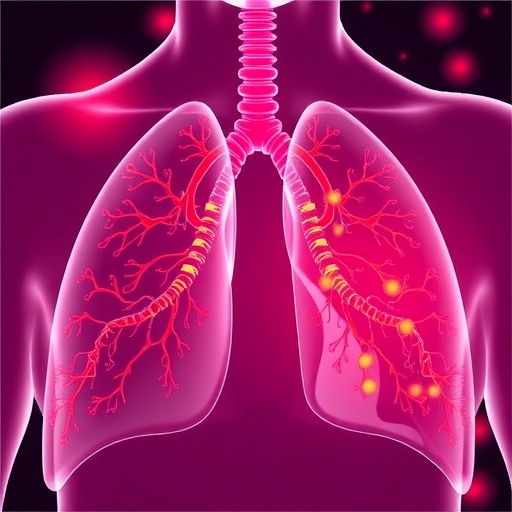
In the evolving landscape of lung cancer treatment, the integration of immune checkpoint inhibitors (ICIs) with conventional chemotherapy regimens has marked a significant milestone, offering renewed hope for improved survival outcomes. Yet, as these combination therapies gain prominence, the complexity of their safety profiles warrants rigorous real-world evaluation. A recent study, drawing insights from the FDA Adverse Event Reporting System (FAERS), has embarked on delineating the nuanced risks associated with the combined use of pembrolizumab alongside pemetrexed and platinum-based chemotherapy in lung cancer patients.
Lung cancer remains a formidable adversary in global oncology, persisting as one of the leading causes of cancer-related mortality. While platinum-based chemotherapies paired with pemetrexed have long served as cornerstones of treatment, the advent of pembrolizumab—a programmed death-1 (PD-1) inhibitor—has revolutionized therapeutic strategies. Pembrolizumab’s mechanism, by reactivating the immune response against tumor cells, significantly augments clinical efficacy, yet simultaneously poses challenges in managing immune-related adverse events.
Leveraging the vast repository of post-marketing surveillance data within FAERS, researchers analyzed adverse event reporting trends spanning from mid-2017 to late 2024. This timeframe captures the progressive adoption of pembrolizumab in clinical practice and allows for a robust comparative safety assessment between chemotherapy alone and its combination with immunotherapy. The utilization of sophisticated statistical measures including the Reporting Odds Ratio (ROR) and Bayesian Confidence Propagation Neural Network (BCPNN) ensured a nuanced detection of disproportionality signals amid the vast dataset.
The study encompassed a considerable pool of adverse event reports, with 2,871 cases linked to chemotherapy alone and 5,443 reports associated with the addition of pembrolizumab. This disparity underscores the growing clinical reliance on combination regimens but also highlights the imperative need to dissect the safety landscape meticulously. Intriguingly, combination therapy revealed a conspicuous elevation in the incidence of renal and urinary disorders, hepatobiliary complications, as well as respiratory conditions such as interstitial lung disease and pneumonitis.
Of particular concern is the identification of interstitial lung disease (ILD) and pneumonitis as emergent adverse events that surfaced with greater frequency under combination treatment. These pulmonary toxicities not only bear significant morbidity but also complicate ongoing management, necessitating vigilant monitoring protocols. The researchers’ findings advocate for heightened clinical awareness, especially in the critical initial three months post-treatment commencement—a window wherein the onset of adverse events appears most pronounced.
Delving deeper, the study dissected subgroup variations, unearthing that patient-specific factors such as gender and age materially influence susceptibility to adverse reactions. This insight dovetails with the broader imperative for personalized medicine; tailoring surveillance and therapeutic adjustments to patient demographics could mitigate risks and enhance tolerability. The differential impact observed across these subgroups also prompts further investigation into underlying biological or pharmacokinetic mechanisms.
An additional facet of clinical importance is the altered timeline of adverse event manifestation observed with combination therapy. Unlike chemotherapy alone, where adverse events tend to present relatively rapidly, the inclusion of pembrolizumab was associated with a prolonged time to onset. This delayed toxicity potential demands extended follow-up and may have profound implications for long-term patient management and quality of life.
The methodology underpinning this pharmacovigilance study is noteworthy for its integration of multiple disproportionality algorithms. These analytical tools—spanning frequentist approaches like ROR and PRR to Bayesian frameworks like BCPNN and MGPS—fortify the rigor of signal detection. Such multi-dimensional analysis mitigates the risk of false positives and enhances confidence in identifying true safety concerns within heterogeneous real-world data.
While randomized clinical trials (RCTs) remain the gold standard for efficacy and preliminary safety evaluation, post-marketing surveillance via the FAERS database offers invaluable real-world insights that RCTs may miss. Variations in patient populations, co-morbidities, and treatment adherence encountered in routine practice accentuate the relevance of these findings, reinforcing the nuanced toxicity spectrum that emerges beyond controlled trial settings.
These revelations bear significant clinical repercussions. Oncologists must navigate the therapeutic promise of pembrolizumab-enhanced regimens against a backdrop of heightened adverse event risk. Early detection strategies, thorough patient education, and tailored monitoring—especially among vulnerable subgroups—are essential to optimize outcomes while minimizing harm. Furthermore, these data could guide modification of treatment protocols to balance efficacy with safety.
Future research trajectories might encompass mechanistic explorations to elucidate why combination therapy predisposes patients to renal, hepatic, and pulmonary toxicities. Additionally, integrating biomarker studies could enable preemptive identification of patients at elevated risk, potentially refining candidate selection for combination protocols. Such precision oncology approaches would harmonize therapeutic aggressiveness with safety considerations.
This study also underscores the evolving role of pharmacovigilance databases as critical instruments in contemporary oncology. Harnessing big data analytics enables clinicians and regulators to detect emerging drug safety signals promptly, fostering adaptive strategies in cancer care. The convergence of immunotherapy with chemotherapy, while transformative, therefore necessitates continuous vigilance and dynamic evidence synthesis.
In summary, the confluence of pemetrexed, platinum, and pembrolizumab in lung cancer treatment exemplifies both therapeutic innovation and complexity. This comprehensive FAERS analysis delineates a heightened yet manageable risk landscape, reinforcing the import of personalized treatment paradigms and vigilant adverse event monitoring. As immune-oncology continues to advance, such insights will be indispensable in refining the delicate equilibrium between treatment benefits and potential harms.
The journey toward conquering lung cancer is marked by incremental yet significant strides. Integrating real-world evidence into clinical decision-making not only deepens understanding of treatment safety but also empowers clinicians to optimize patient-centric care. With enhanced awareness of these adverse event profiles, the oncology community can better harness the full potential of immuno-chemotherapy combinations, navigating challenges toward improved survival and quality of life for patients worldwide.
—
Subject of Research: The safety profile and adverse event risks associated with pemetrexed and platinum chemotherapy with or without pembrolizumab in lung cancer patients, analyzed through the FAERS pharmacovigilance database.
Article Title: The real-world safety profile of pemetrexed and platinum with or without pembrolizumab: insights from a comparative analysis of FAERS database
Article References:
Li, S., Huang, Z., Zhong, X. et al. The real-world safety profile of pemetrexed and platinum with or without pembrolizumab: insights from a comparative analysis of FAERS database.
BMC Cancer 25, 767 (2025). https://doi.org/10.1186/s12885-025-14171-3
Image Credits: Scienmag.com
DOI: https://doi.org/10.1186/s12885-025-14171-3
Tags: adverse events in lung cancer therapycancer survival outcomeschemotherapy and immunotherapy integrationcombination therapies in oncologyFDA Adverse Event Reporting Systemimmune-related adverse events managementlung cancer treatment safetyPD-1 inhibitors in lung cancerpembrolizumab immune checkpoint inhibitorspemetrexed and platinum chemotherapypost-marketing surveillance datareal-world evaluation of cancer drugs





